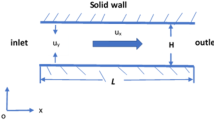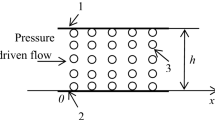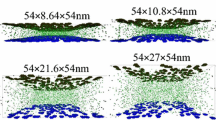Abstract
Non-equilibrium molecular dynamics simulations are employed in order to access the detailed atomic behavior of fluids moving in nanochannels and to quantify the associated energy dissipation. Nanochannels of various degrees of wall hydrophobicity/hydrophilicity and roughness are studied. Dimensional arguments that include the role of the atomistic model parameters allow us to derive a functional expression for the Darcy–Weisbach friction factor, f, so that macroscopic flow estimates of f can be compared to those for nanochannel flows. The NEMD simulations allow us to take into account parameters such as wall/fluid interaction which are neglected in the macroscopic theories and embed proposed modifications in classical relations. The methodology forms the basis for generating Moody’s-like diagrams for nanoscale conduit flows where the range of the relative roughness parameter is significantly larger than in macroflows.




Similar content being viewed by others
Abbreviations
- A :
-
Cross-sectional area in a channel
- D :
-
Diffusion coefficient
- \(D_{\text{h}}\) :
-
Hydraulic diameter
- f :
-
Darcy–Weisbach friction factor
- \(f_{\text{ext}}\) :
-
Magnitude of external driving force
- \(h\) :
-
Channel width
- \(h_{\text{av}}\) :
-
Theoretical channel width
- \(h_{\text{l}}\) :
-
Wall roughness length
- \(h_{\text{d}}\) :
-
Wall roughness height
- H loss :
-
Energy loss per unit mass
- J p :
-
Microscopic stress tensor
- K :
-
Spring constant
- k B :
-
Boltzman constant
- L :
-
Length of a channel segment
- M :
-
Total mass
- m :
-
Particle mass
- N :
-
Number of particles
- r eq :
-
Position of a wall atom on fcc lattice site
- r i :
-
Position vector of atom i
- \({\mathbf{r}}_{ij}\) :
-
Distance vector between ith and jth atom
- Re :
-
Reynolds number
- T :
-
Temperature
- \(u(r_{ij} )\) :
-
LJ potential of atom i with atom j
- \(\rlap{--} V\) :
-
Volume
- v :
-
Average fluid velocity at a channel cross-section
- \(\dot{\gamma }\) :
-
Strain rate
- Δp :
-
Pressure drop
- ε f :
-
Fluid energy parameter in the LJ potential
- ε w :
-
Wall energy parameter in the LJ potential
- θ :
-
Contact angle
- μ :
-
Coefficient of shear viscosity
- ν :
-
Coefficient of kinematic viscosity
- ρ f :
-
Fluid density
- ρ w :
-
Wall density
- σ f :
-
Fluid length parameter in the LJ potential
- σ w :
-
Wall length parameter in the LJ potential
References
Ashurst WT, Hoover WG (1975) Dense-fluid shear viscosity via nonequilibrium molecular dynamics. Phys Rev A 11:658–678
Asproulis N, Drikakis D (2011) Wall mass effects on hydrodynamic boundary slip. Phys Rev E 84:031504
Asproulis N, Drikakis D (2013) An artificial neural network-based multiscale method for hybrid atomistic-continuum simulations. Microfluid Nanofluid 15:559–574
Asproulis N, Kalweit M, Drikakis D (2012) A hybrid molecular continuum method using point wise coupling. Adv Eng Softw 46:85–92
Bernardo P, Drioli E, Golemme G (2009) Membrane gas separation: a review/state of the art. Ind Eng Chem Res 48:4638–4663
Cao BY, Chen M, Guo ZY (2006) Liquid flow in surface-nanostructured channels studied by molecular dynamics simulation. Phys Rev E 74:066311
Cao BY, Sun J, Chen M, Guo ZY (2009) Molecular momentum transport at fluid–solid interfaces in MEMS/NEMS: a review. Int J Mol Sci 10:4638–4706
Cao BY, Li Y-W, Dong R-Y, Kong J, Chen H, Xu Y, Yung K-L (2011) Superhydrophobicity of self-organized surfaces of polymer nanowire arrays fabricated by a nano-injection moulding technique. J Therm Sci Technol Jpn 6:204–209
Cottin-Bizonne C, Barentin C, Bocquet L (2012) Scaling laws for slippage on superhydrophobic fractal surfaces. Phys Fluids 24:012001
Davies J, Maynes D, Webb BW, Woolford B (2006) Laminar flow in a microchannel. Phys Fluids 18:087110
Delhommelle J, Petravic J, Evans DJ (2004) Non-Newtonian behavior in simple fluids. J Chem Phys 120:6117–6123
Gargiuli J, Shapiro E, Gulhane H, Nair G, Drikakis D, Vagdama P (2006) Microfluidic systems for in situ formation of nylon 6,6 membranes. J Membr Sci 282:257–265
Giannakopoulos AE, Sofos F, Karakasidis TE, Liakopoulos A (2012) Unified description of size effects of transport properties of liquids flowing in nanochannels. Int J Heat Mass Transf 55:5087–5092
Grannick S (1991) Motions and relaxations of confined liquids. Science 253:1374–1379
Herwig H, Gloss D, Wenterodt T (2008) A new approach to understanding and modeling the influence of wall roughness on friction factors for pipe and channel flows. J Fluid Mech 613:35–53
Kalweit M, Drikakis D (2010) On the behavior of fluidic material at molecular dynamics boundary conditions used in hybrid molecular-continuum simulations. Mol Simul 36:657–662
Kandlikar SG, Schmitt D, Carrano AL, Taylor JB (2005) Characterization of surface roughness effects on pressure drop in single phase flow in minichannels. Phys Fluids 17:100606
Kleinstreuer C, Li J, Koo J (2008) Microfluidics of nano-drug delivery. Int J Heat Mass Transf 51:5590–5597
Koplik J, Banavar JR (2006) Slip, immiscibility, and boundary conditions at the liquid-liquid interface. Phys Rev Lett 96:044505
Koplik J, Banavar JR, Willemsen J (1988) Molecular dynamics of Poiseuille flow and moving contact lines. Phys Rev Lett 60:1282–1285
Markesteijn AP, Hartkamp R, Luding S, Westerweel J (2012) A comparison of the value of viscosity for several water models using Poiseuille flow in a nano-channel. J Chem Phys 136:134104
Maynes D, Jeffs K, Woolford B, Webb BW (2007) Laminar flow in a microchannel with hydrophobic surface patterned microribs oriented parallel to the flow direction. Phys Fluids 19:093603
Moody LF (1944) Friction factors for pipe flow. ASME Trans J Appl Mech 66:671–677
Myers TG (2011) Why are slip lengths so large in carbon nanotubes? Microfluid Nanofluid 10:1141–1145
Nikuradse J (1933) Laws of flow in rough pipes [“Stromungsgesetze in Rauen Rohren,” VDI-Forschungsheft 361]
Noy A, Park HG, Fornasiero F, Holt JK, Grigoropoulos CP, Bakajin O (2007) Nanofluidics in carbon nanotubes. Nano Today 2:22–29
Ohara T, Suzuki D (2001) Intermolecular momentum transfer in a simple liquid and its contribution to shear viscosity. Microsc Thermophys Eng 5:117–130
Pas MF, Zwolinski BJ (1991) Computation of the transport coefficients of dense fluid neon, argon, krypton and xenon by molecular dynamics. Mol Phys 73:471–481
Priezjev NV (2007) Effect of surface roughness on rate-dependent slip in simple fluids. J Chem Phys 127:144708
Ritos K, Mattia D, Calabro F, Reese JM (2014) Flow enhancement in nanotubes of different materials and lengths. J Chem Phys 140:014702
Sbragaglia M, Benzi R, Biferale L, Succi S, Toschi F (2006) Surface roughness–hydrophobicity coupling in micro and nanochannel flows. Phys Rev Lett 97:204503
Sofos F, Karakasidis TE, Liakopoulos A (2009) Transport properties of liquid argon in krypton nanochannels: anisotropy and non-homogeneity introduced by the solid walls. Int J Heat Mass Trans 52:735–743
Sofos F, Karakasidis TE, Liakopoulos A (2010) Effect of wall roughness on shear viscosity and diffusion in nanochannels. Int J Heat Mass Trans 53:3839–3846
Sofos F, Karakasidis TE, Liakopoulos A (2012) Surface wettability effects on flow in rough wall nanochannels. Microfluid Nanofluid 12:25–31
Thomas JA, McGaughey AJH (2007) Effect of surface wettability on liquid density, structure, and diffusion near a solid surface. J Chem Phys 126:034707
Tretheway DC, Meinhart CD (2002) Apparent fluid slip at hydrophobic microchannel walls. Phys Fluids 14:L9–L12
Valdés JR, Miana MJ, Martínez M, Gracia L, Pütz T (2007) Numerical investigation of the influence of roughness on the laminar incompressible fluid flow through annular microchannels. Int J Heat Mass Transf 50:1865–1878
Valdés JR, Miana MJ, Martínez M, Gracia L, Pütz T (2008) Introduction of a length correction factor for the calculation of laminar flow through microchannels with high surface roughness. Int J Heat Mass Transf 51:4573–4582
Vinogradova OI (1995) Drainage of a thin liquid-film confined between hydrophobic surfaces. Langmuir 11:2213–2220
Voronov RS, Papavassiliou DV, Lee LL (2006) Boundary slip and wetting properties of interfaces: correlation of the contact angle with the slip length. J Chem Phys 124:204701
Walther JH, Ritos K, Cruz-Chu ER, Megaridis CM, Koumoutsakos P (2013) Barriers to superfast water transport in carbon nanotube membranes. Nano Lett 13:1910–1914
Ybert C, Barentin C, Cottin-Bizonne C, Joseph P, Bocquet L (2007) Achieving large slip with superhydrophobic surfaces. Phys Fluids 19:123601
Zhu Y, Granick S (2002) Limits of the hydrodynamic no-slip boundary condition. Phys Rev Lett 88:106102
Acknowledgments
This project was implemented under the “ARISTEIA II” Action of the “OPERATIONAL PROGRAMME EDUCATION AND LIFELONG LEARNING” and is co-funded by the European Social Fund (ESF) and National Resources.
Author information
Authors and Affiliations
Corresponding author
Rights and permissions
About this article
Cite this article
Liakopoulos, A., Sofos, F. & Karakasidis, T.E. Friction factor in nanochannel flows. Microfluid Nanofluid 20, 24 (2016). https://doi.org/10.1007/s10404-015-1699-5
Received:
Accepted:
Published:
DOI: https://doi.org/10.1007/s10404-015-1699-5




